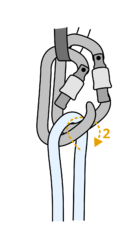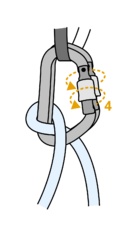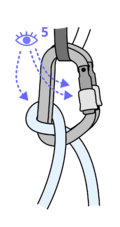Garda hitch
| Garda hitch | |
|---|---|
 | |
| Use(s) | (self-)rescue techniques, material hauling |
| Pros | Fast, simple, just two carabiners needed |
| Cons | It goes only one-way and its almost impossible to release when loaded, can slip in specific cases |
| Category | Hitch |
| Strength | rope: slipping ~35% (specific cases), breaking ~45-60%[1] |
Garda hitch is one of the elementary hitches used among other applications in creavase self-rescue. It is very versatile hitch, yet its application scope is limited mainly by its unidirectional nature and in some cases by possible safety issues.
Tying
Steps description: The two carabiners used should be identical for the knot to work properly! First hang a rope onto two carabiners (1), I personally prefer D-biners with a screw-gate. Next take the rear strand and wrap it around the front carabiner as illustrated (2). You finalize the garda hitch by taking the left rope and move it above the loop, the loop seats itself into the corner of the D-biners. Do not forget to screw the gates (4) and inspect both the gates and the garda hitch itself (5).
Slippage
Garda hitch is prone to slip in some cases, as illustrated and studied by Ryan Jenks (HowNOT2).[1] In general, the smaller the rope diameter and the bigger/more round the carabiners, the easier is for the hitch to slip. The lowest recorded slippage force was at just 2.4 kN (oval screw-gate carabiners used with 6mm nylon sling). In case of 9mm nylon rope, limit force was generally ~8-10 kN (desheating) except for the oval screw-gate carabiners (6 kN, slipping). In general, slippage should therefore not be an issue as long as a climbing rope together with D-shaped carabiners is used.
References
- ↑ 1.0 1.1 Jenks, Ryan (4 September 2024). Could you survive with just 2 carabiners?. HowNOT2. Retrieved 16 August 2025.




